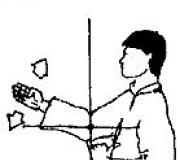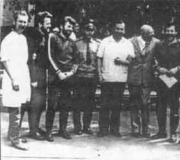Ackoff Emery on purposeful BBC systems. Book: R. Ackoff “On Purposeful Systems. See also in other dictionaries
ABSTRACT
in the discipline "Systems Theory and System Analysis"
"Classification of systems"
Completed:
III year student 320 gr.
Specialties POVT and AS
Sandu R.A.
Checked:
Teacher
Pavlinov I.A.
Rybnitsa, 2012
Content
Introduction........................................................ ........................................................ ................................ 3
1.Open and closed systems.................................................... ................................................ 4
2. Goal-oriented and goal-oriented systems.................................................. ................ 7
3. classification of systems by complexity................................................... ................................ 10
4. Classification of systems by degree of organization.................................................... ....... 14
Conclusion................................................. ........................................................ ........................... 17
LITERATURE................................................. ........................................................ ........................... 18
Introduction
The word “organization” comes from the Latin organize - to do together, to look harmonious, to arrange. Organization is viewed as a process and as a phenomenon. As a process, it is a set of actions leading to the formation and improvement of relationships between parts of the whole, for example, the process of creating an efficient team.
Organization theory is based on systems theory. A system is a whole created from parts and elements for purposeful activity. Sometimes a system is defined as a set of interconnected operating elements. The characteristics of a system are the multitude of its constituent elements, the unity of the main goal for all elements, the presence of connections between them, the integrity and unity of the elements, the presence of structure and hierarchy, relative independence and the presence of control over these elements. The term “organization” in one of its lexical meanings also means “system”, but not any system, but to a certain extent ordered, organized.
Let's consider the classification of systems according to various aspects.
Open and closed systems
There are two main types of systems: closed and open. A closed system has rigid, fixed boundaries; its actions are relatively independent of the environment surrounding the system. A clock is a familiar example of a closed system. The interdependent parts of the watch move continuously and very precisely once the watch is wound or the battery is inserted. And as long as the watch has a source of stored energy, its system is independent of the environment.
An open system is characterized by interaction with the external environment. Energy, information, materials are objects of exchange with the external environment through the permeable boundaries of the system. Such a system is not self-sustaining; it depends on energy, information and materials coming from outside. In addition, an open system has the ability to adapt to changes in the external environment and must do so in order to continue to function.
Closed ones are characterized by determinism and linear development. Open systems involve the exchange of matter, energy, information with the outside world at any point, as well as the stochastic nature of the processes, sometimes bringing randomness to a determining position. Managing such systems involves developing the optimal option based on the study of many options for making management decisions.
Managers are primarily concerned with open systems because all organizations are open systems. The survival of any organization depends on the outside world. The approaches developed by the early schools of management could not suit all situations because they assumed, at least implicitly, that organizations are closed systems. They did not actively consider the environment as an important variable in management.
Large components of complex systems, such as organizations, people, or machines, are often systems themselves. These parts are called subsystems. The concept of a subsystem is an important concept in management. By dividing an organization into departments, which is discussed in subsequent chapters, management intentionally creates subsystems within the organization. Systems such as departments, departments, and various levels of management each play an important role in the organization as a whole, just like the subsystems of your body such as circulation, digestion, nervous system, and skeleton. The social and technical components of an organization are considered subsystems.
Subsystems can, in turn, consist of smaller subsystems. Since they are all interdependent, the malfunction of even the smallest subsystem can affect the system as a whole. The work of every department and every employee in an organization is very important to the success of the organization as a whole.
Understanding that organizations are complex open systems consisting of several interdependent subsystems helps explain why each of the schools of management has proven to be practical only to a limited extent. Each school sought to focus on one subsystem of the organization. The behaviorist school was mainly concerned with the social subsystem. Schools of scientific management and management science mainly focusing on technical subsystems. Consequently, they often failed to correctly identify all the major components of the organization. Neither school seriously considered the impact of the environment on the organization. More recent research shows that this is a very important aspect of organizational performance. There is now a widespread view that external forces can be the main determinants of an organization's success, determining which tools in the management arsenal are appropriate and most likely to be successful.
Rice. Figure 2 is a simplified representation of an organization as an open system. As inputs, the organization receives information, capital, human resources and materials from the environment. These components are called inputs. During the transformation process, the organization processes these inputs, converting them into products or services. These products and services are the organization's outputs that it releases into the environment. If the management organization is effective, then during the transformation process an added value of inputs is generated. As a result, many possible additional outputs appear, such as profit, increased market share, increased sales (in business), implementation of social responsibility, employee satisfaction, organizational growth, etc.
Rice. 2. The organization is an open system.
Since this is a fairly new approach, we cannot yet fully assess the true impact of this school on management theory and practice. Nevertheless, we can already say that his influence is great and, it seems to me, will grow in the future. According to Professors Rosenzweig and Kast, systems theory provided the management discipline with a framework for integrating concepts developed and proposed by earlier schools. Many of these earlier ideas, although they may not be considered entirely correct, are of great value. On a systematic basis, it will probably be possible to synthesize new knowledge and theories that will be developed and appear in the future.
However, systems theory itself does not tell managers which elements of the organization as a system are especially important. It only says that an organization consists of numerous interdependent subsystems and is an open system that interacts with the external environment. This theory does not specifically identify the major variables that influence the management function. It also does not determine what in the environment affects management and how the environment affects the results of the organization's activities. Obviously, managers must know what the variables of the organization as a system are in order to apply systems theory to the management process. This identification of variables and their impact on organizational performance is the main contribution of the situational approach, which is a logical extension of systems theory.
The homeostat, a mechanism of self-regulation and self-education of the system, which allows it to resist external disturbances or restructure itself for the purpose of self-preservation, becomes of great importance in the management of complex systems. In this connection, management should be based on the natural processes of self-regulation of society.
Homeostat is a model of a living organism that imitates its ability to maintain certain values within physiologically acceptable limits, i.e. adapt to environmental conditions.
Goal-oriented and goal-oriented systems.
Goal-directed systems are systems capable of choosing their behavior depending on an intrinsic goal.
In goal-directed systems, the goal is formed within the system.
Example. The aircraft-pilot system is capable of setting a goal and deviating from the route.
An element of purposefulness is always present in a system that includes people (or, more broadly, living beings). The question most often consists of the degree of influence of this focus on the functioning of the object. If we are dealing with manual production, then the influence of the so-called human factor is very large. An individual, a group of people or an entire team is able to set a goal for their activities that is different from the goal of the company.
Active systems, which primarily include organizational, social and economic ones, are called “soft” systems in foreign literature. They are capable of deliberately providing false information and deliberately not fulfilling plans and tasks if it is beneficial to them. An important property of such systems is foresight, which ensures the system’s ability to predict the future consequences of decisions made. This, in particular, makes it difficult to use feedback to control the system.
In addition, sometimes in practice systems are conventionally divided into systems that strive for a goal - goal-oriented, and systems that are oriented, first of all, not to goals, but to certain value-oriented ones.
Any organization is a purposeful system of activity. All forms of organizations appear and develop as unique responses to the various tasks that a person or group of people sets for themselves in the course of their purposeful activities. An engineering approach can be applied to the process of creating and functioning of organizations, which makes it possible to design effective organizational systems.
... the purpose of the goal and the choice of means to achieve it make up the meaning
studying systems. The existence of systems theory is justified
the opportunity to achieve what you want with its help
system state.
An organization arises when between some initial objects (in particular, people and/or groups of people) natural relationships that are stable over a certain period of time arise, updating or limiting some properties of the system being created or transformed.
The creation and functioning of organizations are variants of a purposeful system of activity, and the organizations themselves (enterprises, companies, concerns, communities, clubs, etc.) actually act as tools for achieving their goals. At the same time, the specific set of declared goals can vary within very wide limits - from extracting material benefits to resolving political, social, moral and ethical or any other contradictions. Thus, all forms of organizations appear and develop as unique responses to the multitude of tasks that a person or group of people sets for themselves in the course of their purposeful activities.
Among the systems created by people, we can distinguish a special category of so-called purposeful systems - these are systems that contain people as their components. From the point of view of goal analysis, such systems are particularly complex objects.
As an illustration, consider the evolution of Western society's views on enterprise.
Before the First World War, any enterprise was viewed in only one way - as a mechanism that provided profit to its owner. Like any other mechanism, it was built arbitrarily: it was assumed that there were no patterns in the functioning and development of the enterprise. Because of this, the attitude towards the enterprise’s employees was as if they were parts of a mechanism without taking into account their needs, interests, desires, capabilities, and the laws of their own human existence.
After the First World War, many social, political, and economic processes taking place in Western society forced us to look at the enterprise with new eyes. The realization has come that it is more of an organism than a mechanism, that is, an object, a system that has its own laws of development. Such as, for example, growth, survival, the presence of complementary bodies, the need for an intellectual governing body. This was a period when the management layer at enterprises - management - was intensively growing and developing.
And finally, the processes of a number of recent decades, especially after the Second World War, have led the Western world to the idea of an enterprise as an organization in the broad social sense of the word, that is, a voluntary association of owners and employees who are carriers of individual goals. Therefore, the goal of a modern enterprise cannot be reduced, as noted above, to obtaining maximum profit.
The goal of a modern enterprise is the sum of the goals of all its employees, owners, consumers and, strictly speaking, all other subjects of society somehow connected with it. In order to distinguish the goals of human-containing systems from any others, all systems should be divided into two classes - mechanical and organic systems.
|
Manufacturer: "Book on Demand" This book is an attempt to develop a system of concepts that allows us to describe and explain human behavior as a “system of purposeful actions.” Of course, the authors are far from the first researchers of human behavior. It is enough to point to the behaviorists, the book devotes a lot of space to a critical analysis of whose work. However, so far a unified view has not been developed on this complex problem and it is impossible to talk about the creation of an objective scientific theory. R. Ackoff and F. Emery critically revised the extensive material and proposed their own concept; their book introduces the reader to both their own views and the history of the issue. Reproduced in the original author's spelling of the 1974 edition (Soviet Radio publishing house). Publisher: "Book on Demand" (2012) Format: 84x108/16mm, 270 pages.
He received his Bachelor of Architecture from the University of Pennsylvania. Other books on similar topics:See also in other dictionaries:One of the elements of behavior and consciousness. human activity, which characterizes the anticipation in thinking of the result of an activity and the way of its implementation with the help of definitions. funds. C. acts as a way to integrate various actions... ... Philosophical Encyclopedia Activities aimed at increasing the efficiency of firms, companies, organizations. Contents 1 Types of management consulting 1.1 Strategic consulting ... Wikipedia One of the elements of behavior and conscious activity (See Activity) of a person, which characterizes the anticipation in thinking of the result of an activity and the ways of its implementation using certain means. C. acts as a way... ... Great Soviet Encyclopedia Psychological compatibility is a characteristic of long-term interaction between two or more individuals, in which the manifestations of stable character traits inherent in these individuals do not lead to long-term and insoluble, without external ... ... Wikipedia This article needs to be completely rewritten. There may be explanations on the talk page. This term has other meanings, see Adaptation... Wikipedia - (also diversity index) a dimensionless indicator used in biology to determine the degree of uniformity in the distribution of characteristics of sample objects. The dual concept for diversity is the concept of homogeneity or concentration.... ... Wikipedia Preface Model A 1 2 4 3 6 5 7 8 The table is compiled from the text from the pages Socionic type (aspect-by-aspect descriptions there are presented grouped by socionic... Wikipedia MZhK, abbr., abbreviation 1. youth residential complex. 2. MZhK social movement in the USSR in 1971 1991 (peak activity 1984 1991). 3. Member of the MZhK emzhekovets (zh. emzhekovka). Commemorative plaque on the country's first residential building of the multi-residential complex (city... ... Wikipedia MZhK, abbr., abbreviation 1. youth residential complex. 2. MZhK social movement in the USSR in 1971 1991 (peak activity 1984 1991). 3. Member of the MZhK emzhekovets (zh. emzhekovka). Initially it was intended as a way to create normal housing and... ... Wikipedia MZhK, abbr., abbreviation 1. youth residential complex. 2. MZhK social movement in the USSR in 1971 1991 (peak activity 1984 1991). 3. Member of the MZhK emzhekovets (zh. emzhekovka). Initially it was intended as a way to create normal housing and... ... Wikipedia |
Focused, goal-oriented systems
When studying economic and organizational objects, it is important to distinguish the class targeted, or purposeful, systems In this class, in turn, we can distinguish systems in which goals are set externally(usually this is the case in closed systems), and systems in which goals are formed within the system(which is typical for open, self-organizing systems).
The patterns of goal formation in self-organizing systems are discussed below. Methods that help form and analyze goal structures are discussed in Chapter. 5.
Classification of systems by complexity
There are several approaches to dividing systems by complexity.
Terms first "big system" And "a complex system" were used as synonyms. Some researchers have linked complexity to the number of elements. Thus, W. R. Ashby believed that the system is big from point of view observer, whose capabilities it exceeds in some aspect important for achieving goals.
In this case, the same material object, depending on the purpose of the observer and the means at his disposal, can be displayed or not displayed big system and, in addition, the physical dimensions of an object are not a criterion for assigning an object to a class large systems
N. P. Buslenko proposed, due to the lack of a clear definition of classifying a system as large and the relative convention of this concept, to connect the concept large system with what role they play in studying the system complex system-wide issues, which, naturally, depends on the properties of systems and classes of problems being solved.
For the spheres of biological, economic, social systems, sometimes the concept of a large system was associated to a greater extent with concepts important for such systems emergence, openness, activity of elements, as a result, such a system has a kind of “free will”, unstable and unpredictable behavior and other characteristics developing, self-organizing systems.
B. S. Fleishman takes as the basis for classification behavioral complexity systems
At the same time, there are other points of view: since these are different words in natural language, they should be used as different concepts.
There are more convincing justifications for the difference between the concepts " big system" And " a complex system".
In particular, Yu. I. Chernyak suggests calling big system “one that cannot be studied otherwise than by subsystems”, A complex – “a system that is built to solve a multi-purpose, multi-aspect problem.”
Explaining these concepts with examples, Yu. I. Chernyak emphasizes that in the case big system, an object can be described as if in one language, those. using a single modeling method, albeit in parts, subsystems (Fig. 3.16, A). A complex the system reflects the object “from different sides in several models, each of which has its own language,” and to harmonize these models a special metalanguage(Fig. 3.16, b).
Rice. 3.16.
Chernyak connects the concepts of a large and complex system with the concept "observer": for studying big system is necessary one "observer"(this does not mean the number of people taking part in the research or design of a system, but the relative homogeneity of their qualifications: for example, engineer or economist), but for understanding complex systems - necessary some“observers” with fundamentally different qualifications (for example, a mechanical engineer, programmer, computer specialist, economist, and possibly a lawyer, psychologist, etc.).
This emphasizes the presence of complex systems of “complex, composite goals” or even “different goals” and “simultaneously many structures in one system (for example, technological, administrative, communication, functional, etc.).” Subsequently, Chernyak clarifies these definitions. In particular, when determining big systems he introduces the concept "a priori identified subsystems" and when determining complex– concept "incomparable aspects of an object's characteristics" and includes in the definition the need to use several "languages" And different models.
One of the most complete and interesting classifications by difficulty level proposed K. Boulding . The levels highlighted in it are given in table. 3.3.
Table 3.3
Classification of systems according to K. Boulding
|
System type |
Difficulty level |
Concepts, models |
|
|
Living systems |
Transcendental systems or systems that currently lie outside our knowledge |
Integral Concepts |
|
|
Social systems |
Social organizations |
Sociological concepts Integral Concepts |
|
|
Systems characterized by self-awareness, thinking and non-trivial behavior |
Physiological, psychological concepts |
||
|
Living organisms with a more developed ability to perceive information, but not self-aware |
Animals |
Biological concepts and models |
|
|
Living organisms with low ability to perceive information |
Plants |
Chemical and biological concepts and models |
|
|
Open systems with a self-preserving structure (the first stage at which separation into living and nonliving is possible) |
Homeostat, cells |
|
|
|
Nonliving systems |
Cybernetic systems with controlled feedback loops |
Thermostat |
|
|
Simple dynamic structures with a given law of behavior |
Clockwork |
|
|
|
Static structures (skeletons) |
Crystals |
Physics and mathematics concepts and models |
In K. Boulding’s classification, each subsequent class includes the previous one, is characterized by a greater manifestation of the properties of openness and stochastic behavior, more pronounced manifestations of the patterns of hierarchy and historicity (see paragraph 1.5), although this is not always noted, as well as more complex “mechanisms” functioning and development.
Assessing classifications of systems from the point of view of their use in choosing methods for modeling them, it should be noted that such differences (up to the choice of mathematical methods) exist in them only for classes of relatively low complexity (in K. Boulding’s classification, for example, for the level of non-living systems ), for which models based on the fundamental principles of automatic control theory can be used: program control, deviation control (feedback model), a model that combines the principle of deviation control and compensatory control (or feedforward control) by including a compensation block in the model, measuring interference and making recommendations for adjusting the control law.







